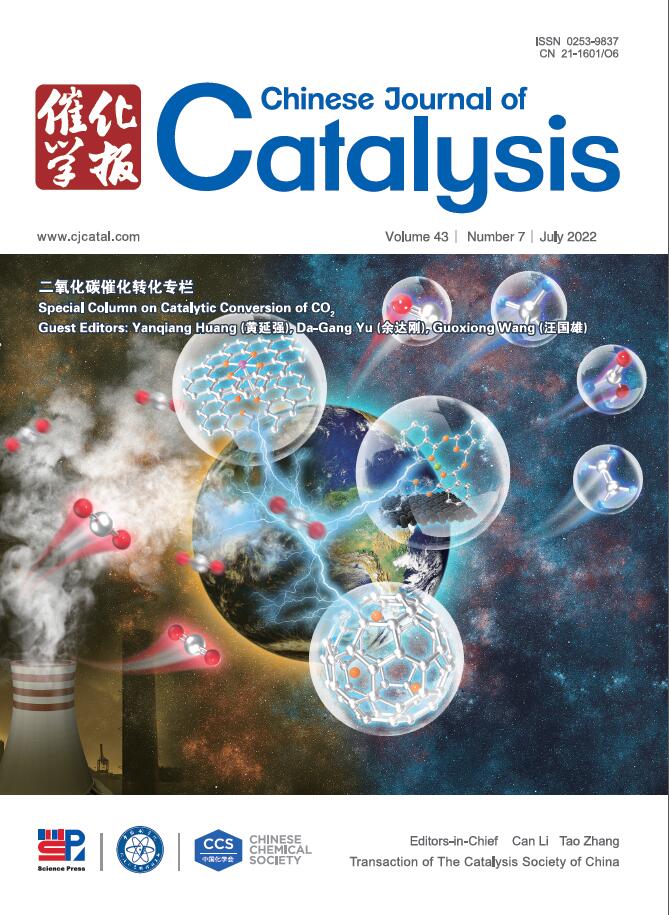Synergistic sites over the ZnxZrO catalyst for targeted cleavage of the C–H bonds of ethane in tandem with CO2 activation
IF 15.7
1区 化学
Q1 CHEMISTRY, APPLIED
引用次数: 0
Abstract
The CO2-assisted oxidative dehydrogenation of ethane (CO2-ODHE) provides a promising way to produce ethylene and utilize CO2. Simultaneous upgrading of ethane into the high value–added chemical products and the reduction of greenhouse gas CO2 emissions could be achieved. However, the targeted breaking of the C–C/C–H bonds of ethane is still a challenge for the designed catalysts. In this paper, ZnO-doped ZrO2 bifunctional catalysts (ZnxZrO) with different Zn/Zr molar ratios were prepared by the deposition-precipitation method, and the functions of various sites for CO2-ODHE reaction were revealed by in situ characterizations and ethane pulse experiment: the medium-strength acidic Zn-O-Zr sites are responsible for the purposefully cracking of ethane C–H bonds to ethylene, while the more oxygen vacancies (OV) created by the introduction of Zn2+ are responsible for the efficient activation C=O bonds of CO2, thus promoting the RWGS reaction. In addition, the Zn0.2ZrO catalyst demonstrated excellent catalytic performances, with C2H6 conversion, C2H4 yield, and CO2 conversion about 19.1%, 10.5%, and 10.6% within 5 h, respectively (600 °C, GHSV = 3000 mL/(g·h)). Especially, the initial ethylene space-time yield of 355.5 μmol/(min·g) was obtained under 6000 mL/(g·h); Finally, the tandem reaction mechanism of ethane dehydrogenation and RWGS was revealed.
ZnxZrO催化剂上的协同位点对乙烷的C-H键进行靶向裂解,并与CO2激活
二氧化碳辅助乙烷氧化脱氢(CO2- odhe)为乙烯的生产和二氧化碳的利用提供了一条很有前途的途径。可以实现乙烷向高附加值化工产品升级的同时,减少温室气体CO2的排放。然而,有针对性地破坏乙烷的C-C / C-H键仍然是设计催化剂的一个挑战。本文采用沉积-沉淀法制备了不同Zn/Zr摩尔比的zno掺杂ZrO2双功能催化剂(ZnxZrO),并通过原位表征和乙烷脉冲实验揭示了CO2-ODHE反应中各位点的功能:中等强度的酸性Zn-O-Zr位点是乙烷C - h键有目的地裂解成乙烯的原因,而引入Zn2+产生的更多氧空位(OV)是有效激活CO2的C=O键的原因,从而促进了RWGS反应。此外,Zn0.2ZrO催化剂表现出优异的催化性能,在600℃,GHSV = 3000 mL/(g·h)下,5 h内C2H6转化率、C2H4产率和CO2转化率分别达到19.1%、10.5%和10.6%。在6000 mL/(g·h)条件下,乙烯的初始空时产率可达355.5 μmol/(min·g);最后,揭示了乙烷脱氢与RWGS的串联反应机理。
本文章由计算机程序翻译,如有差异,请以英文原文为准。
求助全文
约1分钟内获得全文
求助全文
来源期刊

Chinese Journal of Catalysis
工程技术-工程:化工
CiteScore
25.80
自引率
10.30%
发文量
235
审稿时长
1.2 months
期刊介绍:
The journal covers a broad scope, encompassing new trends in catalysis for applications in energy production, environmental protection, and the preparation of materials, petroleum chemicals, and fine chemicals. It explores the scientific foundation for preparing and activating catalysts of commercial interest, emphasizing representative models.The focus includes spectroscopic methods for structural characterization, especially in situ techniques, as well as new theoretical methods with practical impact in catalysis and catalytic reactions.The journal delves into the relationship between homogeneous and heterogeneous catalysis and includes theoretical studies on the structure and reactivity of catalysts.Additionally, contributions on photocatalysis, biocatalysis, surface science, and catalysis-related chemical kinetics are welcomed.
 求助内容:
求助内容: 应助结果提醒方式:
应助结果提醒方式:


